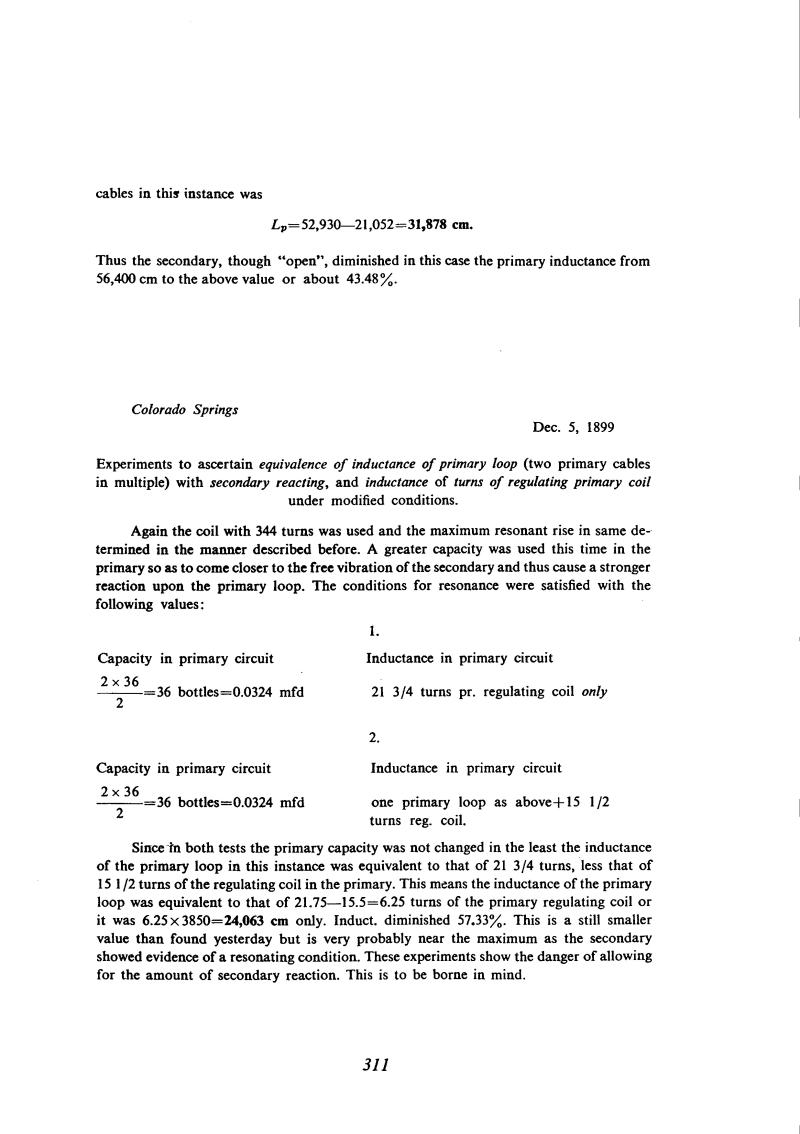
Nikola Tesla Books
cables in this instance was
Lp = 52,930 - 21,052 = 31,878 cm.
Thus the secondary, though âopenâ, diminished in this case the primary inductance from 56,400 cm to the above value or about 43.48%.
Colorado Springs
Dec. 5, 1899
Experiments to ascertain equivalence of inductance of primary loop (two primary cables in multiple) with secondary reacting, and inductance of turns of regulating primary coil under modified conditions.
Again the coil with 344 turns was used and the maximum resonant rise in same determined in the manner described before. A greater capacity was used this time in the primary so as to come closer to the free vibration of the secondary and thus cause a stronger reaction upon the primary loop. The conditions for resonance were satisfied with the following values:
| 1. | |
| Capacity in primary circuit | Inductance in primary circuit |
| $! {{2 \times 36} \over 2} $! = 36 bottles = 0.0324 mfd | 21 3/4 turns pr. regulating coil only |
| 2. | |
| Capacity in primary circuit | Inductance in primary circuit |
| $! {{2 \times 36} \over 2} $! = 36 bottles = 0.0324 mfd | one primary loop as above + 15 1/2 turns reg. coil. |
Since in both tests the primary capacity was not changed in the least the inductance of the primary loop in this instance was equivalent to that of 21 3/4 turns, less that of 15 1/2 turns of the regulating coil in the primary. This means the inductance of the primary loop was equivalent to that of 21.75 - 15.5 = 6.25 turns of the primary regulating coil or it was 6.25 x 3850 = 24,063 cm only. Induct. diminished 57.33%. This is a still smaller value than found yesterday but is very probably near the maximum as the secondary showed evidence of a resonating condition. These experiments show the danger of allowing for the amount of secondary reaction. This is to be borne in mind.
311
December 5
He continues similar measurements as on the previous day, but the secondary selffrequency is closer to operating frequency, at this, as during previous measurements, he finds "primary inductance reduced due to secondary reaction". If we for the moment exclude the circuit of the "additional" coil and calculate free frequencies, at which the oscillation of Tesla's oscillator with very good inductive coupling could be expected. With equal self-resonant frequencies of both linked circuits, we get:
Ï0 = $! {l \over \sqrt{LC}} $! Ï1 = $! {l \over \sqrt{LC(l-K)}} $! Ï2 = $! {l \over \sqrt{LC(l+K)}} $!
From the equation for Ï1, it is obvious that it would not be interpreted as self-resonant frequency of a circuit of which the capacitance is C, the inductance is L(l-K). For the value of Tesla's oscillator primary circuit inductance (please see November 9) we get "reduced" L, i.e., L(l-K) = 23,094cm and Tesla obtained by measurement 24,063cms.

